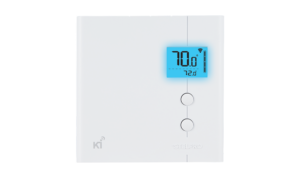Smart technology has brought convenience and efficiency to various aspects of our lives, and one area where it has made a significant impact is home temperature control. Traditional thermostats are gradually being replaced by their smarter counterparts, such as the Line Voltage Smart WiFi Thermostat. In this article, we will explore the features, benefits, and installation process of these innovative devices, as well as their impact on energy efficiency and cost savings.
How Does a Line Voltage Smart WiFi Thermostat Work?
Line Voltage Smart WiFi Thermostats are designed to regulate the temperature of spaces where line voltage systems are used, such as baseboard heaters and radiant floor heating systems. Unlike low voltage thermostats, which operate on 24-volt systems, line voltage thermostats handle higher voltage levels, typically 120 to 240 volts.

These smart thermostats leverage WiFi connectivity to provide users with remote control and access through smartphone apps or web interfaces. They connect to the home’s WiFi network, allowing users to adjust the temperature settings from anywhere, at any time. This seamless integration of smart technology and temperature control makes line voltage smart WiFi thermostats a game-changer in the HVAC industry.
Benefits of Line Voltage Smart WiFi Thermostats
- Energy Efficiency: Line voltage smart WiFi thermostats enable precise temperature control, minimizing energy wastage and reducing utility bills. They can automatically adjust the temperature based on occupancy patterns and optimize heating cycles for maximum efficiency.
- Cost Savings: By utilizing advanced programming and scheduling features, these thermostats help homeowners save on heating costs by ensuring that energy is only consumed when needed. The ability to remotely control and monitor the thermostat also allows users to make real-time adjustments to further optimize energy usage.
- User-Friendly Features: Line voltage smart WiFi thermostats are designed with user convenience in mind. They offer intuitive interfaces, touchscreens, and easy-to-navigate mobile apps, making it simple for homeowners to set temperature preferences and customize schedules according to their lifestyle.
- Integration with Smart Home Systems: These thermostats can seamlessly integrate with existing smart home systems, allowing users to control temperature settings along with other connected devices such as lighting and security systems. This integration enhances the overall smart home experience and offers centralized control through a single app or voice commands.
- Advanced Programming and Scheduling: Line voltage smart WiFi thermostats provide advanced programming options, enabling users to create personalized temperature schedules that align with their daily routines. Whether it’s adjusting the temperature for different times of the day or setting specific temperatures for various zones within the home, these thermostats offer unparalleled flexibility.
- Remote Access and Control: With the ability to connect to the thermostat remotely, users can monitor and adjust temperature settings even when they are away from home. This feature is particularly beneficial for frequenttravelers or individuals who want to ensure their home is comfortable upon their return.
- Voice Control and Compatibility with Virtual Assistants: Many line voltage smart WiFi thermostats are compatible with popular virtual assistants like Amazon Alexa or Google Assistant. This integration allows users to control the thermostat using voice commands, adding an extra layer of convenience to the overall user experience.
- Security and Privacy Considerations: When it comes to smart devices, security and privacy are essential. Reputable line voltage smart WiFi thermostat brands prioritize data encryption and employ robust security measures to protect user information. It’s crucial for users to choose trusted brands and follow best practices to ensure their privacy and security.

Popular Line Voltage Smart WiFi Thermostat
Mysa Smart Thermostat
If you’re using electric baseboard heaters at home, Mysa offers an excellent choice in line voltage smart thermostats worth considering.
When it comes to Mysa’s thermostat option, one of its standout features is its sleek and minimal design that complements any interior style or home decor. It boasts advanced functionality, allowing you to control it through various smart assistants such as Google Assistant, SmartThings, Amazon Alexa, and HomeKit, as well as through IFTTT integration.
The Mysa Smart Thermostat is compatible with both 120V and 240V line voltage systems and requires only one neutral or second live wire for installation. It also provides the convenience of smartphone app control, allowing you to easily adjust settings and access useful features like scheduling and geofencing. With geofencing, you can program the thermostat to ensure optimal comfort even before you arrive home. Additionally, it offers energy usage tracking capabilities to help you manage your electricity bills effectively.
Key Features:
- Compatible with IFTTT, Google Assistant, SmartThings, Amazon Alexa, HomeKit
- Smartphone app support
- Requires one neutral or second live wire
- Works with 120V and 240V systems
- 2-year warranty
Pros:
- Provides insights into energy usage
- Includes geofencing feature
- Convenient Wi-Fi pairing
Cons:
- Maximum capacity limited to 3700 Watts
Stelpro Z-Wave Plus Thermostat
Next on our list is an affordable thermostat option from Stelpro, a well-established and highly regarded brand in the market.
The Stelpro KI Z-wave thermostat is designed to work with 240V line voltage systems and can effectively control heaters with a 2-wire connection. For a complete Z-wave experience, it pairs seamlessly with the Z-wave gateway controller (sold separately). However, it also offers easy smartphone pairing and integration with popular platforms such as SmartThings, Vera, HomeSeer, Nexia, and Wink.
Furthermore, this thermostat allows for additional customization and automation by pairing with various sensors like door sensors, temperature sensors, or motion sensors. It prioritizes energy efficiency and includes a dedicated Eco Mode to help you reduce electricity consumption and save on utility bills.
Key Features:
- Compatible with SmartThings, Vera, HomeSeer, Nexia, and Wink
- Smartphone app support
- Works with 2-wire connection to heaters
- Supports 240V line voltage
- 3-year warranty
Pros:
- Energy-efficient operation
- Affordable pricing
- Easy installation process
Cons:
- Not compatible with 120V systems

KING K902-B Hoot Smart Thermostat
For those seeking a premium line voltage smart thermostat, King is a reputable and well-known brand that offers a wide range of reliable devices in this category.
This thermostat option from King delivers a highly convenient user experience with its Hoot smartphone app support, which is both simple to install and use. Additionally, the thermostat features a large touchscreen display for easy operation. It utilizes Wi-Fi connectivity and supports automatic installation of over-the-air updates, ensuring that your device stays up to date with the latest features and improvements.
The standout feature of this smart thermostat is its ability to program 4-6 time periods per day, allowing you to set different temperature settings for maximum flexibility. It is compatible with 120V, 208V, and 240V systems and utilizes electronic temperature sensing for precise control over your heating needs.
- Key Features:
- Features a large LCD touchscreen display
- Hoot Smartphone app support
- Programmable 4-6 time periods per day
- Works with 120V, 208V, and240V
- 2-year warranty
Pros:
- Large backlit buttons for easy operation
- Receives OTA updates for seamless functionality
- Accurate temperature sensing for precise control
Cons:
- Does not support smart assistants
Common Troubleshooting Issues and Solutions
- Issue 1: Thermostat not connecting to WiFi
- Solution: Check the WiFi connection and ensure the thermostat is within range. Restart both the thermostat and the WiFi router if necessary.
- Issue 2: Inaccurate temperature readings
- Solution: Calibrate the thermostat by comparing its readings to a separate thermometer. Recalibration may be required if significant discrepancies are found.
- Issue 3: Compatibility issues with the HVAC system
- Solution: Verify the compatibility of the line voltage smart WiFi thermostat with the specific HVAC system. Consult the manufacturer’s guidelines or seek professional assistance if needed.

Maintenance and Upkeep
To keep your line voltage smart WiFi thermostat running smoothly, regular maintenance is necessary. Here are some maintenance tips:
- Clean the thermostat screen and casing regularly with a soft, dry cloth to prevent dust buildup.
- Ensure the thermostat’s sensors are clean and free from debris for accurate temperature readings.
- Check the battery status if your thermostat has a backup battery. Replace it as needed to prevent power failures.
- Update the thermostat’s firmware to access new features and security enhancements.
Conclusion
Line voltage smart WiFi thermostats have revolutionized temperature control in homes equipped with line voltage heating systems. Their seamless integration of smart technology, energy efficiency features, and user-friendly interfaces make them a compelling choice for homeowners seeking convenience and cost savings.
By enabling remote access, advanced scheduling, and integration with smart home systems, these thermostats provide an enhanced level of control over home temperature settings. As technology continues to advance, line voltage smart WiFi thermostats will likely become even more sophisticated, contributing to a more comfortable and energy-efficient future.
You May Also Enjoy Reading: Chamberlain Myq Smart Garage Hub Review
FAQs
- Can I install a line voltage smart WiFi thermostat myself?
- It’s recommended to consult a professional for installation, especially if you’re not familiar with electrical systems. They can ensure proper installation and compatibility with your heating system.
- Can I use a line voltage smart WiFi thermostat with my existing baseboard heaters?
- Yes, line voltage smart WiFi thermostats are compatible with baseboard heaters and other line voltage heating systems.
- Are line voltage smart WiFi thermostats compatible with all smart home systems?
- Most line voltage smart WiFi thermostats are designed to integrate with popular smart home systems. However, it’s essential to check compatibility before making a purchase.
- Can I control the thermostat when I’m not at home?
- Yes, with a line voltage smart WiFi thermostat, you can control and monitor temperature settings remotely using a mobile app or web interface.
- Are line voltage smart WiFi thermostats secure?
- Reputable brands prioritize security measures and employ data encryption to protect user information. However, users should choose trusted brands and follow recommended security practices for optimal protection.

